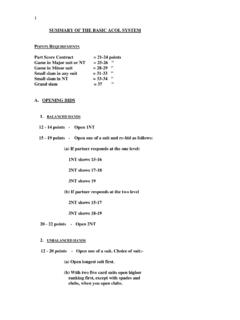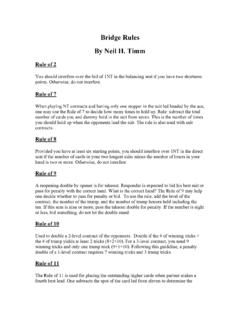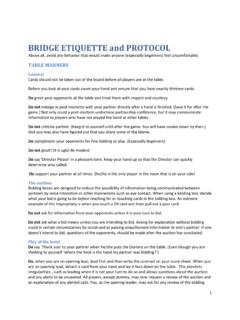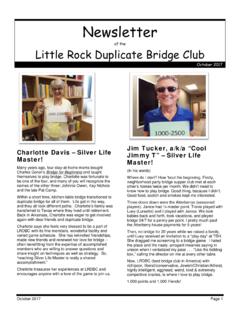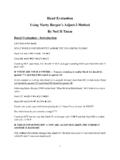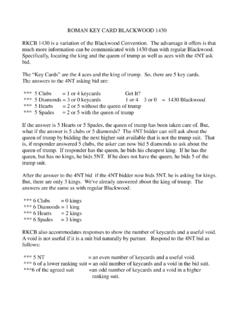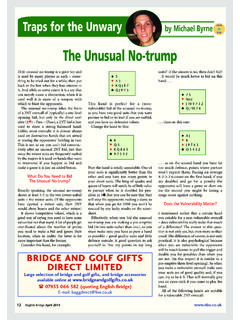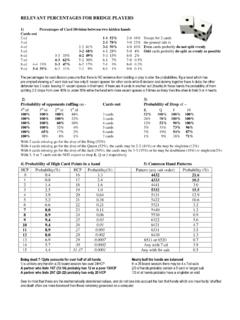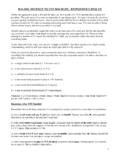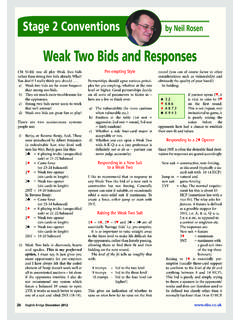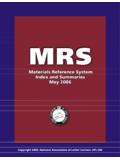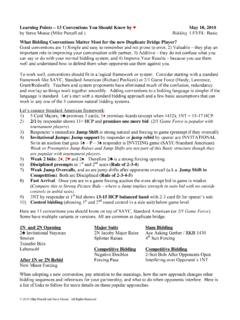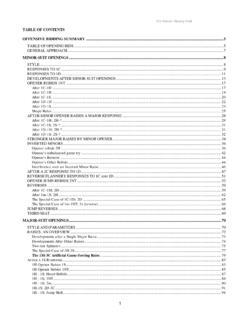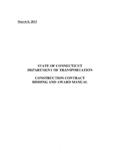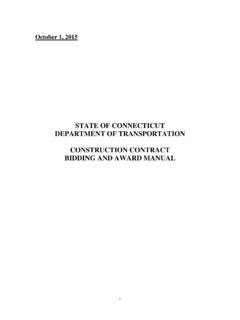Transcription of The Acol Bidding System - BridgeWebs
1 The Acol Bidding System Bids contain a hidden message. Opener's 1 might mean "I promise to take 7 tricks with hearts as trumps", but responder interprets it as a coded message saying: "I have 12-19 points and at least 4 hearts". A Bidding System is a way of co-ordinating these coded messages. The most popular System in Britain, and the System we are teaching you, is called ACOL. The key to understanding Acol is to realise that most bids can be classified into various types. We will illustrate some of these bids by referring to an auction we have already discussed. South West North East 1 P 1 P 1NT P 2 All Pass Limit Bids The Limit bid is the most distinctive feature of Acol. A player makes a bid, which very closely defines his hand strength, leaving partner to use common sense to decide upon the correct contract.
2 In the above auction South's 1NT rebid is a limit bid, showing a balanced hand with 15-16 points. Most Acol auctions feature a limit bid by the second round of Bidding . The following are usually limit bids: (i) No-trump bids (ii) Support of partner's suit (iii) A rebid of your own suit. That doesn't leave much does it? You are left just with introducing a new suit to the auction Wide Ranging Bids A wide ranging bid is the opposite of a limit bid. For example, South's 1 opening covers the range 12-19 points. Clearly responder can very rarely pick the final contract until much more information has been exchanged. Forcing Bids Suppose opener starts with 1 and you, responder, have: A J 7 3 2 J 8 4 Q 8 4 A Q Clearly you want to reach at least a game contract, however as yet you cannot choose between 3NT, 4 , 4 , or even a slam if opener is very strong.
3 You want to show your spades by responding 1 and hear a second bid from partner but you need reassurance that partner won t pass just because he has a minimum opening bid. Unless your opponents intervene your 1 response forces him to bid again. Forcing bids can be divided into two categories! (a) Forcing for one round. The l response to 1 forces opener to find a rebid, but not necessarily a third bid. With the hand shown responder intends to make sure game is reached, but the 1 bid could have concealed just 6 HCP (high card points), making it necessary that the Bidding die quickly unless opener has great strength. (b) Game Forcing. Some bids make en an unconditional demand that that the Bidding be kept open until game is reached, where such a bid is available the partnership clearly has plenty of space to discuss the final contract.
4 Sign-off Bids North's 2 said that he was convinced that this was the best contract and demanded that South pass, called a sign-off. Predictably a sign-off bid often follows a limit bid . Invitational Bids Usually if partner makes a limit bid you can decide between game or part-score without further ado. However sometimes you want further clarification within the narrow limits he has set. If you have a balanced hand with 12 HCP and partner opens 1NT (which shows 12-14 HCP) you only want to play in game if he is at the upper end of this range. You can bid an invitational 2NT, asking him to reassess his hand in the context of what he has already shown. Note that a hand with 14 HCP isn't good or bad in itself.
5 If you have shown 12-14 HCP and partner is still interested in game, 14 HCP is very encouraging. However if you had shown 14-16 HCP then 14 HCP is minimum. Conventional Bids There are those who prefer to play totally natural bridge, where a club bid always shows clubs. However most players choose to replace the natural meaning of some bids by an artificial meaning, generally because that is more useful. Such a bid is called a conventional bid. For example, playing Acol all exceptionally strong hands are opened 2 , whether or not the hand has a club suit. 2 is used purely as a way of creating a game forcing auction. From now onwards we use the following abbreviated notation to classify bids: [L] Limit bid [WR] Wide ranging bid [F] Forcing bid [FIR] Forcing bid for one round [GF] Game Forcing bid [NF] Not forcing [S] Sign-off bid [I] Invitational bid [C] Conventional bid A good way of practicing your Bidding , is to deal hands and bid them with a friend, stating the classification of each bid as you make it.
6 Our sample auction might go as follows} South: "One heart, wide ranging, not forcing" North "One spade, wide ranging, forcing one round" South "One no-trump, limit bid" North "Two spades, sign-off" Opener has a Balanced Hand By now you might think that if opener has at least 13 points he picks a suit with least four cards to bid. It isn't that simple! Suppose you open 1 with: 9 6 5 A K Q J 9 4 3 K 10 6 Partner is quite likely to respond l [F]. What then? You cannot pass as l is forcing You cannot rebid 1NT [L] as that shows 15-16 points. You cannot rebid 2 [L] as that shows at least five hearts. You cannot raise to 2 [L] because partner will think you have 4-card support.
7 You are stuck. The problem is that you opened 1 with no thought as to your rebid, and it is now too late. Common advice is to always have a rebid planned over any possible forcing response. This is good advice, but rather demanding. There is a simpler way. Opener starts by classifying his hand shape as balanced or unbalanced. A balanced hand can have one of the following shape pattern: 4-3-3-3, 4-4-3-2 or sometimes 5-3-3-2. Thus a balanced hand has no singleton or void, and at most one doubleton. If opener has a balanced hand he should aim to show it with a no-trump bid, either on the opening bid or on the rebid if responder changes suit. This doesn't give him any leeway for making a mistake on the first bid.
8 A 1NT [L] opening bid shows 12-14 points. With 12-14 points and a balanced hand opener must open 1NT because all no-trump rebids show a stronger hand than 14 points. Thus with the hand above the correct opening bid was 1NT even though it contains no honour card in spades or diamonds. Of course you might think it would be nice to have the honour cards evenly distributed between the suits, but it is far more important to show your hand type as quickly as possible. Note that opening 1NT doesn't necessarily commit you to a no-trump contract. Armed with the precise knowledge offered by a limit bid responder may choose a superior suit contract. We now look at balanced hands with more than 14 points.
9 The following table shows the strength of no-trump rebids: No-trump Points needed Points needed rebid after a one- after a two-level response level response 1NT [L] 15-16 2NT [LI 17-18 15-16 3NT [L] 19 17-19 So how does opener handle these hands? (a) 6 3 2 (b) Q 10 2 A K Q J A K Q J K 7 3 K 7 3 K 4 2 K 4 2 With (a) he opens 1 (his only 4-card suit) and plans a INT rebid if responder bids1 , or a 2NT rebid if responder bids 2 or 2 . With (b) he opens 1 and plans a 2NT rebid if responder bids 1 , or a 3NT rebid if responder bids 2 or 2.]
10 Don't worry that a higher-level rebid is necessary after a 2 or 2 response. A two-level change of suit promises more points than a one-level response, making the higher rebid safe. How about unbalanced hands? All unbalanced hands have at least one 5-card suit except those with 4-4-4-1 shape; Therefore if opener chooses to show an unbalanced hand by Bidding two suits his first suit is likely to have at least 5 cards. Opener has an Unbalanced Hand With an unbalanced, hand opener plans to bid two suits or rebid his suit. (b) 4 (c) Q J 7 6 5 A Q 9 7 K Q 8 6 3 A 8 4 Q 9 6 4 3 2 K 2 He should open his longest suit. l is correct with (b). At this stage he should pessimistically assume that responder will bid diamonds or spades, one of his short suits.
